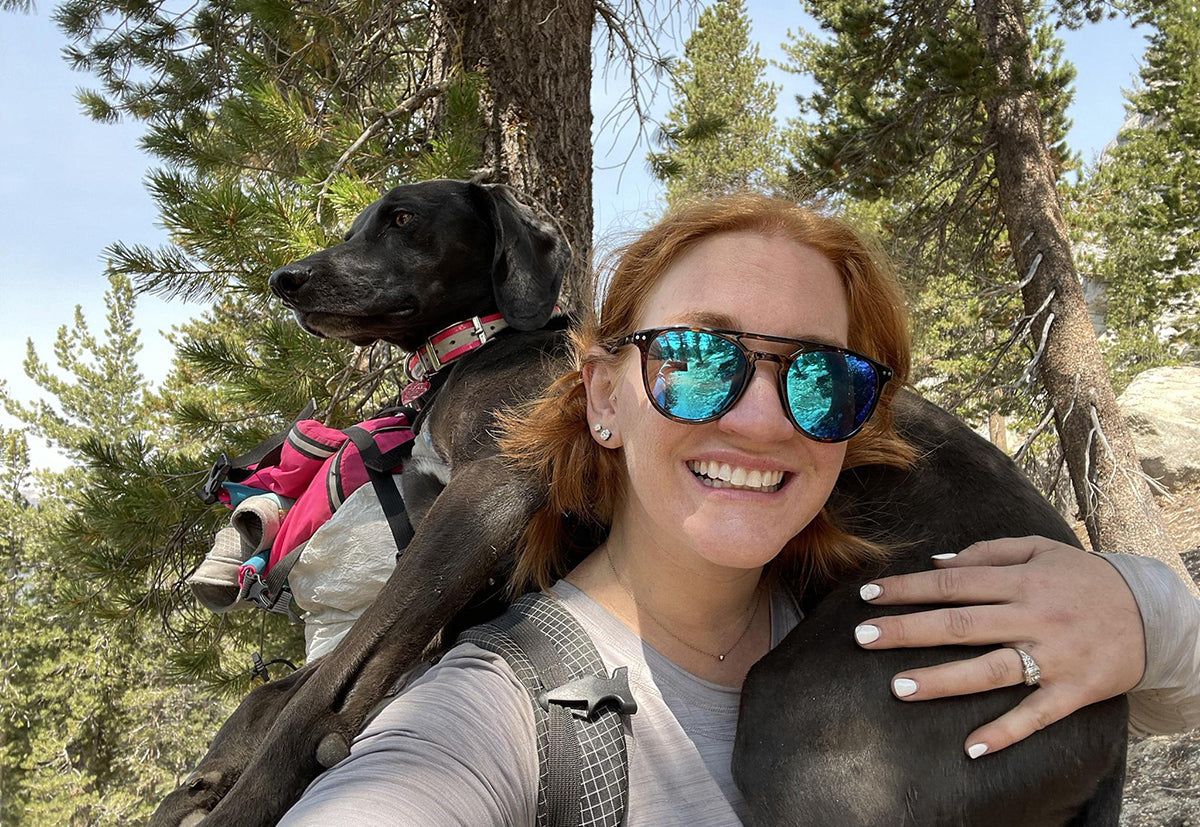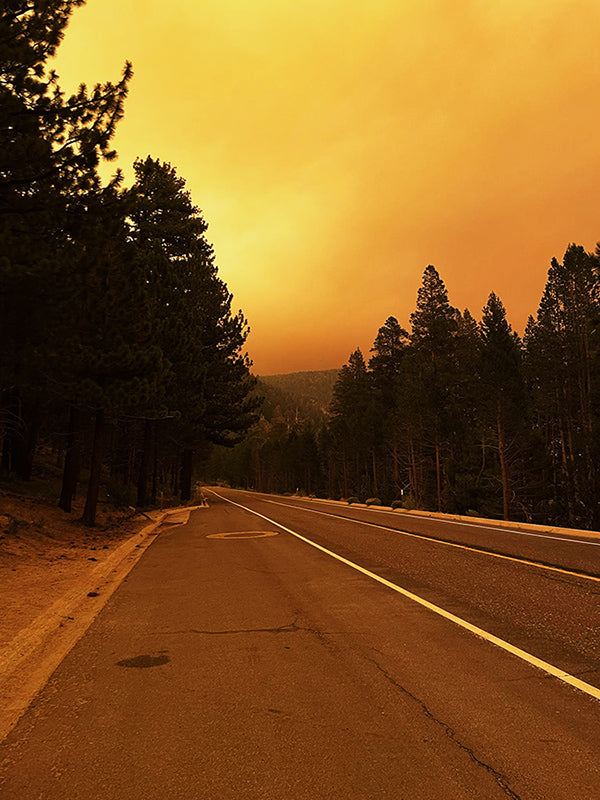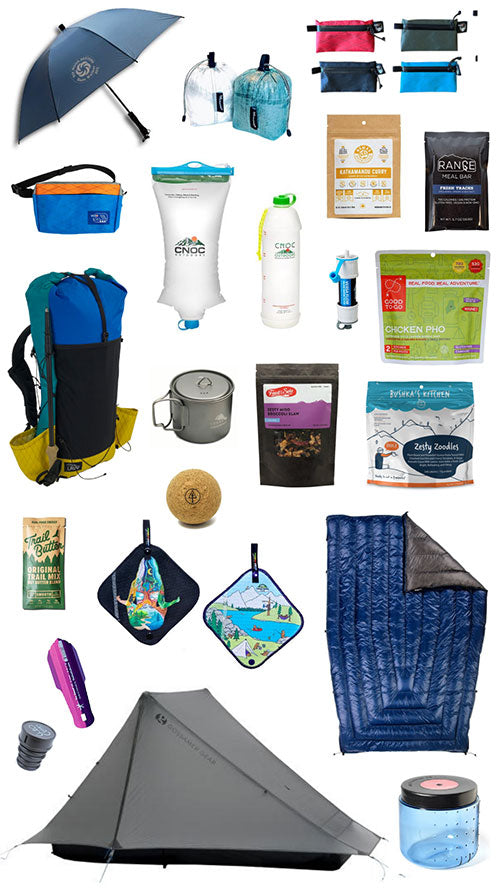
Firefighters fighting the Caldor Fire in Lake Tahoe, September 2021. Photo Courtesy of Sie So.
I woke up in a haze, both figuratively and literally, uncertain about how the next few days would go. I had made it to Hayden Pass the night before, passing out quickly after a 12-hour drive. My trip into Utah’s Uinta Mountain had already been delayed by two days — because a wildfire in Northern California, more than 1,000 miles away, created abysmal air quality.
I was reaching a breaking point. Either I needed to grit my teeth and face the fact that the air quality was less than optimal and backpack anyway, or turn around and head back home. Being extremely stubborn is a trademark flaw of mine. I slung on my pack and set off.
After an hour of easy travel on trail, I looked up the nearly vertical wall of granite I was supposed to start climbing, and realized that my range of visibility was no more than 200 ft. I let out a long exhausted exploitative. The choice was obvious, and I reluctantly turned back.

Hiking through the burn area from the 2021 East Fork Fire in the Uinta Mountains. The smoke from the Dixie Fire can be seen in the air.
My experience reflects the types of decisions hikers in the Mountain West of the United States now face every hiking season.
When selecting a start date, Pacific Crest Trail thru-hikers have to now balance their pace with the snowmelt in the Sierra Nevada and a fire season that comes sooner every year, and overstays its welcome. The same holds true for Continental Divide Trail thru-hikers, but instead of the Sierras, it’s the Rockies.
And it’s not just the wildfires themselves that pose a threat. “A lot of people don’t realize smoke can travel thousands of miles and affect you,” said Sie So, a Triple Crowner who for the last two years has worked as a seasonal wildland firefighter. “When I hiked the Continental Divide Trail in 2017, the wildfire smoke from Washington and Oregon was reaching me in Colorado.”
Every passing year, wildfires and their effects are only becoming more of a concern, and not just for hikers; outdoor recreationists of all stripes are feeling the impacts. With little relief in sight — the National Oceanic and Atmospheric Administration recently released a report that predicts ‘prolonged, persistent drought in the West’ this upcoming summer — it raises several questions.
What causes these wildfires? How do these wildfires affect long-distance hikers and backpackers? … and the local populations we visit? What can we do as individuals to make a difference? And is a true thru-hike of the PCT or CDT in its purest form, an unbroken single continuous footpath, still even possible?

Hiking down from Foresters Pass on the PCT. Early June, 2019. PCT and CDT hikers who enter the Sierra Nevada and San Juans too early respectively, may have to endure extreme snow conditions.
What Causes Wildfires?
There are three essentials wildfires need to thrive: fuel, oxygen, and an ignition source. The ignition source is how we determine the cause of a wildfire; classified as, natural, human or unknown.
The most common cause of a wildfire (natural or human) is a lightning strike hitting a dry patch of vegetation. In 2021, fires caused by lightning accounted for more than 2.6 million acres of burned land and over $1 billion in damages.
Wildfires caused by humans typically happen because of improper supervision of campfires, firearms and fireworks, but it’s certainly not limited to that.
In the case of the 2021 Telegraph Fire, flares employed by jet fighters over highly combustible vegetation during mock aerial dog fights is the most likely culprit. That fire burned more than 200 thousand acres of sensitive desert land.
The Rolling Pines Fire that nearly unhomed my in-laws was caused by county officials losing control of a prescribed burn; another common cause of wildfires started by humans.

The Caldor Fire burning in California, blanketing a valley in the Sawtooth Wilderness with smoke. September 2021.
Of the 38 major wildfires that occurred in 2021, six of them were caused by humans. These fires burned more than 700 thousand acres and cost more than $347 million to fight. Of note, five fires in 2021 had ‘unknown’ causes; these totaled 1.3 million acres burned.
However, so far, we’ve only talked about ignition source; the most immediate cause of wildfires. There is certainly a reason why vegetation is so dry across the Mountain West at this moment, and why lightning events are so prominent.
Human-driven climate change has led to prolonged seasons of excessive heat and dryness. Rain events are largely consolidated to the colder winter months and lightning events are on the increase across North America. Extended periods without precipitation dries vegetation, turning it into fuel for wildfires.
Ironically, wildfires release greenhouse gasses in mass, exasperating a turn toward the type of hot and dry climates that create kindling — not to mention the long-term loss of trees and other vegetation that turn carbon dioxide back into oxygen.

The Mullen Fire in Wyoming, 2020. Photo Courtesy of Sie So.
To further add to the scary equation, the wind speed on earth’s surface has increased substantially since 2010. Quoting directly from the New England Journal of Medicine, “Strong winds provide more oxygen for wildfires and encourage their spread, potentially outstripping firefighting capability.”
The Western United States is currently in year 22 of the worst drought to hit the region in the last 1,200 years. The average person can see the effects of this drought with their naked eye. Lake Mead is filled to 35% of its total capacity, leaving dry lakebed “bathtub rings” where the water that supplies 40 million people in seven states used to be.
What Did the 2021 Wildfire Season Look Like in the US?
The 2021 Wildland Fire Summary and Statistics Annual Report released from the National Interagency Coordination Center (NICC) paints a vivid picture, even with its use of neutral language.
During the early months of last year, the Mountain West saw less than expected precipitation, yet sustained Snow Water Equivalent levels (‘snowpack’ in layman’s terms) above average. However, record-setting high temperatures quickly melted the snow, and by April and May the snowpack had dropped below average.
By June, the drought intensified and fire advisories were broadly issued. Fire season had begun, two to four weeks early.

Smoke lingering on the forest floor. The Caldor Fire, 2021. Photo courtesy of Sie So.
The second half of 2021 saw some of the most catastrophic fire events ever recorded. Millions of people and animals were affected by the Caldor, Dixie, Bootleg River Complex, Monument, Windy, Antelope, Boundary, and Cougar Peak Fires, to name just a few. The drought and record high temperatures did not abate during this time, persisting through late October.
A large wind event in December 2021 started the nation’s 10th largest fire that year, which burned more than 120 thousand acres in Texas, Oklahoma, and Kansas, in just one day.
In 2021, the final tally of acres consumed by wildfires in the United States registered 7 million — nearly the size of Maryland. These fires burned 3,557 homes.
Yet according to the NICC, 2021 is an ‘average’ year, in line with the amount of wildfires counted and acreage burned in the last ten years. In fact, the fires of 2020, consumed more than 10 million acres.

The Pack Creek fire burning the La Sal Mountains in Utah, 2021. Photo courtesy of Pmags.
What the 2022 Wildfire (and Hiking) Season Could Look Like
Despite a record-setting December 2021 snowfall in the Sierra Nevada, a lackluster amount of precipitation in January and February have the mountain range yielding only a 63% snowpack level, when compared to the average.
Northbound (NOBO) hikers on the PCT and CDT might find this information thrilling, as it means potentially being able to safely cross the Sierra Nevada and San Juans earlier in the year. However, the low snowpack level is only one pixel to consider in the broad picture.
It’s also a La Nina year; an atmospheric event that takes place in the Eastern Pacific Ocean when sea temperatures around the equator fall below average. When this occurs, drier conditions in the Western United States are amplified by the warm winds La Nina brings to the region. Meaning, it is entirely possible that the 2022 fire season could start earlier and last longer than that of 2021.
The NICC predicts an elevated risk of wildfires for the Mountain West in 2022, leaving dry conditions in place until the monsoon season, when some relief may come but not reverse the drought's effects.
Thru-hiking During a Wildfire Outbreak

Tellico leading the way! You can see the smoke creeping throughout the sky. Photo courtesy of Lindsey.
Lindsey Grissom was about to begin the Tahoe Rim Trail with her dog Tellico right about the time the Caldor Fire was just beginning. She had planned this hike for months, even going stoveless for the trip so as to not risk any fire.
Much like many working professionals who backpack, she had painstakingly negotiated this time off with her employer. The TRT was “the big hike” of the season for her, and her first major thru-hike since completing the Appalachian Trail.
Lindsey had been in contact with local friends for weeks and was constantly checking the conditions on the ground. From the locals’ vantage point, the hike posed no danger.
The Dixie Fire had been burning for a month at this point and had become the largest fire of the season, but was largely North of Lake Tahoe and was only “lightly affecting” the area. (The Air Quality Index was consistently yielding values well over 100 at the time, so you be the judge of “lightly affecting.”)
This, as it turns out, was the same Dixie Fire that had affected my Uinta Mountains trip in Utah with terrible air quality weeks earlier.

By the evening of the first day of Lindsey’s TRT thru-hike attempt, the sun was largely blotted out by smoke. The sky began to increasingly get darker with a strong orange hue over the next few days.
Lindsey began to think she would need to use a headlamp to walk around during the middle of the day. She began to cough more and had trouble taking in breaths and sleeping at nights.

The sky changed quickly, in the course of one day, during Lindsey's TRT thru-hike attempt. Photo courtesy of Lindsey.
She persevered, but eventually, Tellico began to slow down and act more lethargic as well. A curious development as she loves to backpack. With this bridge crossed, it became blazingly apparent that they needed to get off trail.
Lindsey contacted the few people in Northern California she knew, and began coordinating with them on how to get off trail; given the air quality, wind directions, and road closures caused by the fires.
For the last mile to the trailhead, she had to pick up Tellico, as they refused to hike further. With some persistence and luck, Lindsey was able to hitchhike off the TRT. It was dark enough that the cars on the road needed their headlights to drive in the middle of the afternoon.

Hiking to safety. Lindsey carried her dog for a mile until she was able to thumb a hitch and get off trail. Photo courtesy of Lindsey.
Soon after Lindsay got off trail, the Forest Service closed all national forests in the state of California, to decrease the chance of human endangerment and the chances of human error causing further wildfires.
It took Lindsey a week, and Tellico a few days, to fully recover from their TRT attempt.

Lindsey’s last view from the trail, trying to hitchhike off the TRT. Photo courtesy of Lindsey.
The Future of Wildfires and Thru-Hikes
The TRT is a pretty straightforward hike. It’s a short loop hike with plenty of access points and resupply options. There is even a Farout Guide (formerly known as Guthook) dedicated to the trail. Even so, problem solving is still one of the hardest challenges facing thru-hikers.
Where is the next water source? Where am I camping tonight? Where am I going to resupply? Will the store or post office be open when I get to town?
For Lindsey, one of the hardest things about her thru-hike was the “decision fatigue.” On top of all the regular questions that plague thru-hikers, she also now had to contend with and consider even more important factors.
What’s the latest news on the fire? Is the air quality acceptable? Could I even get off trail safely, if I wanted to?
“I honestly feel bad for PCT hikers these days,” said Sie, the thru-hiker turned wildland firefighter. “That trail is pretty much a roll of the dice in terms of fire closures now. Even if you’re lucky enough not to run into a major fire detour, you’re at some point gonna get caked with smoke, which is terrible for your lungs and it ruins the views.”

Wildland Firefighters hiking into the wilderness to work on preventive measures. Photo courtesy of Sie So.
Tips and Resources for Hikers During Wildfire Season
For this article series, I asked all the people I interviewed a short but multifaceted question: how would you go about planning trips for the Western States in the future? Many of them had similar thoughts.
For Lindsey, she immediately said that she would pick to hike earlier in the season. “Come July and August, the chances of your hike being affected by wildfires increases,” she said.
Lindsey also talked about setting hard limits on what you are willing to accept as dangerous, such as air quality and your proximity to wildfires.
This website run by the EPA tracks in real time air quality and possible fires in your area. I was tipped off by Paul Magnanti and found it to be an invaluable resource while backpacking in Utah and Idaho in the middle and end of fire season.
Bring an N-95 mask; they’re not just for pandemics. Although they may be uncomfortable to wear, they can help protect you from smoke inhalation. (But please take note, they don’t protect you from making bad decisions!)
Follow the rules and respect fire closures. “There’s a reason why we close off sections of a forest. It’s dangerous and people, us firefighters, will be working in there,” Sie explained.

Don’t start campfires during dry conditions, even when it’s legal. “So many fires are started that way,” Sie added.
Paul Magnanti, known widely throughout the backpacking world as Pmags, completely agrees. “For many, campfires are a part of the culture. A part of the aesthetic and appeal of camping. We’ve sat around fires for thousands of years, trading stories,” he said. “But what could have been considered good practice even five years ago, has changed. The West is a dry tinderbox; it's hotter and drier now. Ultimately, there’s going to have to be a culture change.”
Check out Part 2 of this series, featuring more on-the-ground, first-person stories from wildland firefighters and thru-hikers. It brings home what the wildfire data means for everyday lives, both on and off trail.
Rafael ”Horsecake” Mujica is a freelance writer and adventurer based in the Mountain West. You can find him trail running, backpacking, or sampling the best tacos during his free time. Follow all his adventures over on Instragam @horsecake22, or read more of his work over on his website.

















3 comments
Tim
We need to clean up the forest floor of broken limbs, slash and small plants that are growing. If man wants to control fires we should provide forest cleanups and prescribed burns to remove the hazardous materials.
Aaron
Overall, I dig the article, but there are 2 glaring errors that I can’t get over. As former federal crew dude, and current prescribed fire ops dude I gotta correct em.
1) “ The most common cause of a wildfire (natural or human) is a lightning strike hitting a dry patch of vegetation.” This is wrong. Somewhere around 85% of starts are human caused.
2) “ officials losing control of a prescribed burn; another common cause of wildfires started by humans.” This is also wrong. Less than 1% of prescribed fires escape. (And about 99% of those don’t cause damage to any structures)
Eric B.
I was working as a professional trail builder on the Snow Creek section of the PCT in 1980, building the original trail (from scratch). During a full week in late July a fire burned one mountain away, nearer Palm Springs.
None of we trail builders wanted to fight that fire foe $9.00 an hour because were were getting $12.90. an hour as laborers. Our company, Bell Brothers Trail Builders, had in there contract with the US Forest Service that we COULD be called to work as firefighters if necessary,So we suffered through the smokey week praying the pros could do the job, which they did.
Years later north of Kennedy Meadows my Sierra Club group backpacked through a large burn and it was a dirty, shadeless, ugly hike. We were very happy bo get out of it and into some healthy trees.
Sadly, with galloping climate change, there will be many more fore fires and not only in the American west.